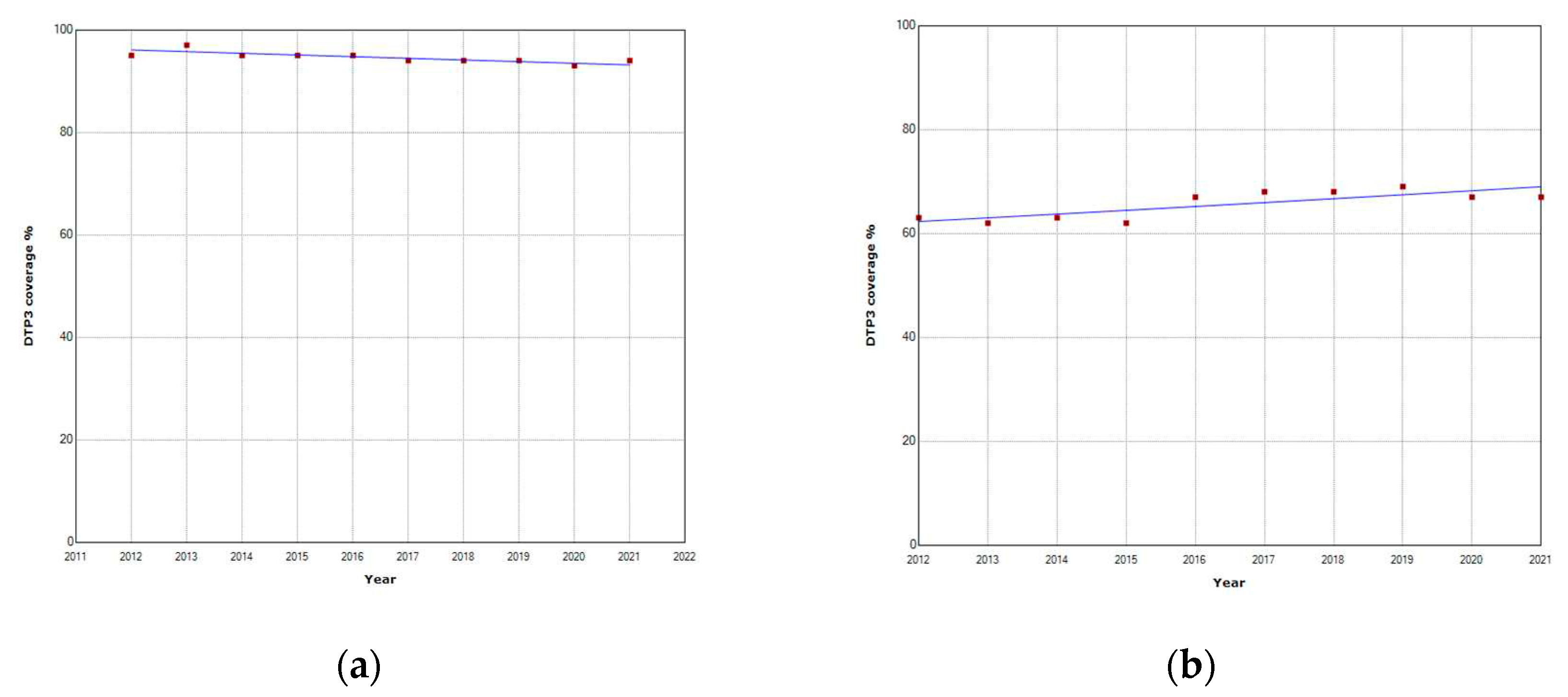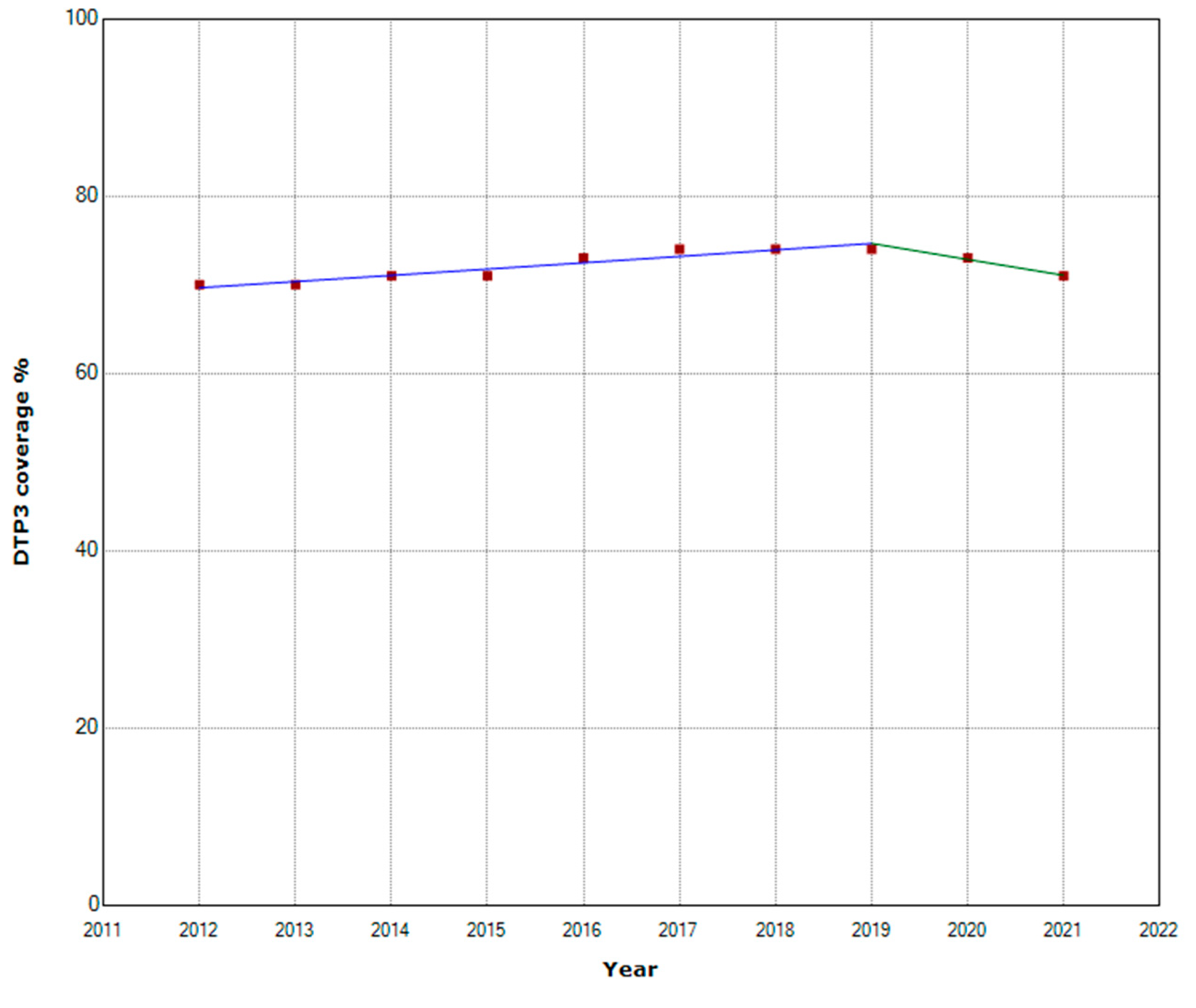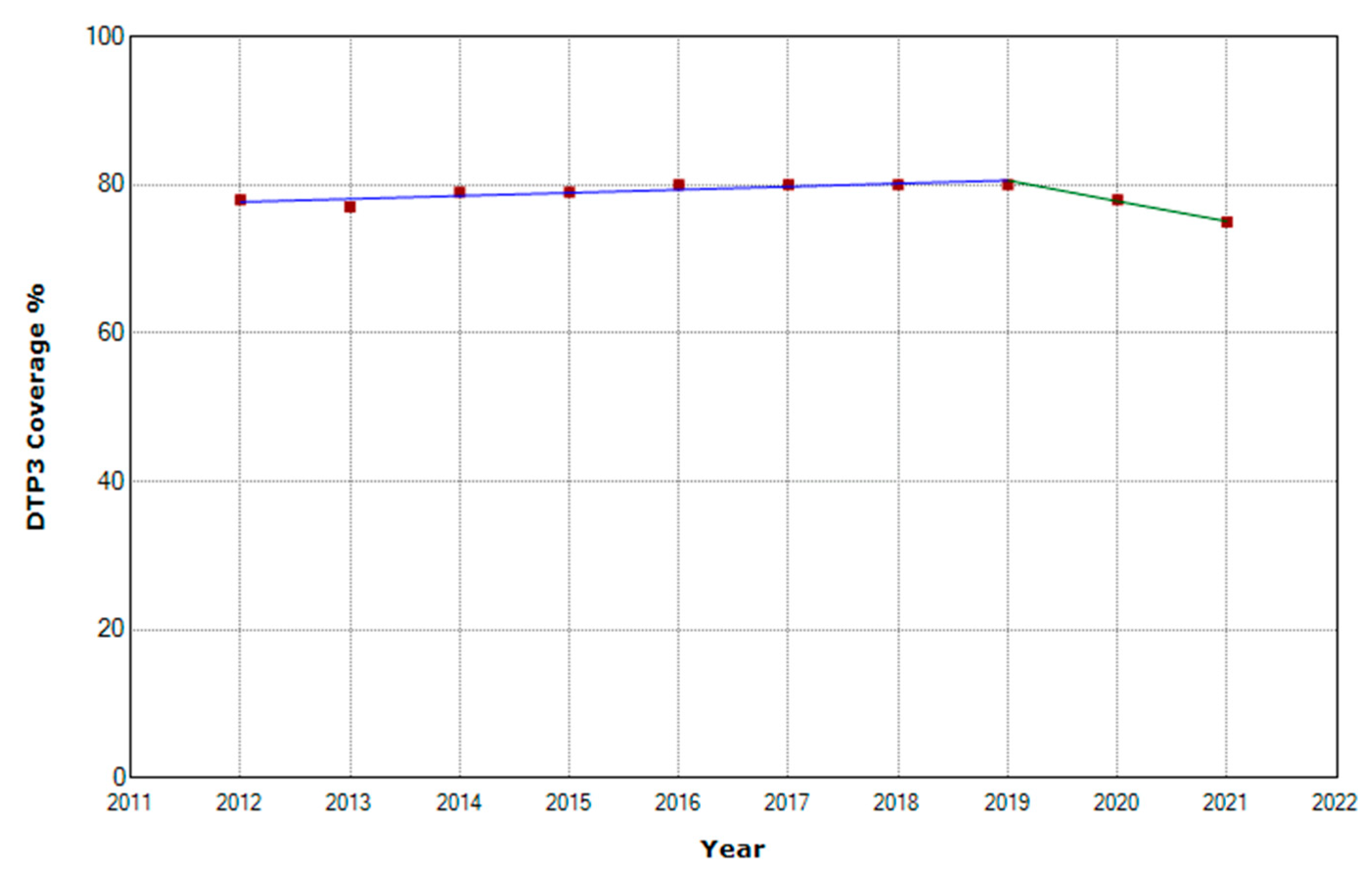Submitted:
30 April 2023
Posted:
01 May 2023
You are already at the latest version
Abstract
Keywords:
1. Introduction
2. Materials and Methods
3. Results

4. Discussion
5. Conclusions
Author Contributions
Funding
Institutional Review Board Statement
Informed Consent Statement
Data Availability Statement
Conflicts of Interest
References
- Ota, M.O.C.; de Moraes, J.C.; Vojtek, I.; Constenla, D.; Doherty, T.M.; Cintra, O.; Kirigia, J.M. Unveiling the Contributions of Immunization for Progressing towards Universal Health Coverage. Hum. Vaccin. Immunother. 2022, 18. [Google Scholar] [CrossRef]
- Suffel, A.M.; Ojo-Aromokudu, O.; Carreira, H.; Mounier-Jack, S.; Osborn, D.; Warren-Gash, C.; McDonald, H.I. Exploring the Impact of Mental Health Conditions on Vaccine Uptake in High-Income Countries: A Systematic Review. BMC Psychiatry 2023, 23, 15. [Google Scholar] [CrossRef]
- Hassan, M.N. A Survey on Hygienic Practices and Immunization Coverage among 12-59 Months Old Children in Urban Slum, Barishal, Bangladesh. Asian J. Med. Biol. Res. 2022, 8, 277–285. [Google Scholar] [CrossRef]
- Stein, R.A. Vaccination: A Public Health Intervention That Changed History & Is Changing with History. Am. Biol. Teach. 2011, 73, 513–519. [Google Scholar] [CrossRef]
- Pan, J.; Wang, Y.; Cao, L.; Wang, Y.; Zhao, Q.; Tang, S.; Gong, W.; Guo, L.; Liu, Z.; Wen, Z.; et al. Impact of Immunization Programs on 11 Childhood Vaccine-Preventable Diseases in China: 1950–2018. Innov. 2021, 2, 100113. [Google Scholar] [CrossRef]
- Espinal, M.A. The Pan American Health Organization: 120 Years in the Americas Hemisphere. Lancet Reg. Heal. - Am. 2023, 21, 100488. [Google Scholar] [CrossRef]
- Zulfan, G.P.; Sihombing, J.A.; Amin, D.M.; Widiantari, A.D.; Berti, M.P.E.; Murtiani, F. Clinical Manifestation of Childhood Diphtheria. J. Ilm. Kedokt. Wijaya Kusuma 2023, 12, 1. [Google Scholar] [CrossRef]
- WHO. Global Vaccine Action Plan 2011-2020; WHO Press: Geneva, 2013. [Google Scholar]
- Macina, D.; Evans, K.E. Bordetella Pertussis in School-Age Children, Adolescents, and Adults: A Systematic Review of Epidemiology, Burden, and Mortality in Africa. Infect. Dis. Ther. 2021, 10, 1097–1113. [Google Scholar] [CrossRef]
- Ayipe, Fidelis Issah and Tanko, M. Public Health Expenditure and Under-Five Mortality in Low-Income Sub-Saharan African Countries: A Panel Data Analysis. (Preprint Available at SSRN: Https://Ssrn.Com/Abstract=4389168 ). 2023. [CrossRef]
- Shahid, A.S.M.S. Bin; Rahman, A.E.; Shahunja, K.M.; Afroze, F.; Sarmin, M.; Nuzhat, S.; Alam, T.; Chowdhury, F.; Sultana, M.S.; Ackhter, M.M.; et al. Vaccination Following the Expanded Programme on Immunization Schedule Could Help to Reduce Deaths in Children under Five Hospitalized for Pneumonia and Severe Pneumonia in a Developing Country. Front. Pediatr. 2023, 11. [Google Scholar] [CrossRef]
- Budu, E.; Ahinkorah, B.O.; Guets, W.; Ameyaw, E.K.; Essuman, M.A.; Yaya, S. Socioeconomic and Residence-based Related Inequality in Childhood Vaccination in Sub-Saharan Africa: Evidence from Benin. Heal. Sci. Reports 2023, 6. [Google Scholar] [CrossRef]
- Santoli, J.M.; Lindley, M.C.; DeSilva, M.B.; Kharbanda, E.O.; Daley, M.F.; Galloway, L.; Gee, J.; Glover, M.; Herring, B.; Kang, Y.; et al. Effects of the COVID-19 Pandemic on Routine Pediatric Vaccine Ordering and Administration — United States, 2020. MMWR. Morb. Mortal. Wkly. Rep. 2020, 69, 591–593. [Google Scholar] [CrossRef]
- Zhong, Y.; Clapham, H.E.; Aishworiya, R.; Chua, Y.X.; Mathews, J.; Ong, M.; Wang, J.; Murugasu, B.; Chiang, W.C.; Lee, B.W.; et al. Childhood Vaccinations: Hidden Impact of COVID-19 on Children in Singapore. Vaccine 2021, 39, 780–785. [Google Scholar] [CrossRef]
- Tolera, S.T.; Kaweti, G.; Aboma, L.M. Article Review on Potential Impact of COVID-19 Pandemic on Socioeconomic of Ethiopia, Africa. Heal. Sci. 2022, 11, 19–30. [Google Scholar]
- He, K.; Mack, W.J.; Neely, M.; Lewis, L.; Anand, V. Parental Perspectives on Immunizations: Impact of the COVID-19 Pandemic on Childhood Vaccine Hesitancy. J. Community Health 2022, 47, 39–52. [Google Scholar] [CrossRef]
- McDonald, H.I.; Tessier, E.; White, J.M.; Woodruff, M.; Knowles, C.; Bates, C.; Parry, J.; Walker, J.L.; Scott, J.A.; Smeeth, L.; et al. Early Impact of the Coronavirus Disease (COVID-19) Pandemic and Physical Distancing Measures on Routine Childhood Vaccinations in England, January to April 2020. Euro Surveill. 2020, 25. [Google Scholar] [CrossRef]
- Lassi, Z.S.; Naseem, R.; Salam, R.A.; Siddiqui, F.; Das, J.K. The Impact of the COVID-19 Pandemic on Immunization Campaigns and Programs: A Systematic Review. Int. J. Environ. Res. Public Health 2021, 18, 988. [Google Scholar] [CrossRef]
- Alsuhaibani, M.; Alaqeel, A. Impact of the COVID-19 Pandemic on Routine Childhood Immunization in Saudi Arabia. Vaccines 2020, 8, 581. [Google Scholar] [CrossRef]
- Palo, S.K.; Dubey, S.; Negi, S.; Sahay, M.R.; Patel, K.; Swain, S.; Mishra, B.K.; Bhuyan, D.; Kanungo, S.; Som, M.; et al. Effective Interventions to Ensure MCH (Maternal and Child Health) Services during Pandemic Related Health Emergencies (Zika, Ebola, and COVID-19): A Systematic Review. PLoS One 2022, 17, e0268106. [Google Scholar] [CrossRef]
- Kiely, M.; Mansour, T.; Brousseau, N.; Rafferty, E.; Paudel, Y.R.; Sadarangani, M.; Svenson, L.W.; Robinson, J.L.; Gagneur, A.; Driedger, S.M.; et al. COVID-19 Pandemic Impact on Childhood Vaccination Coverage in Quebec, Canada. Hum. Vaccin. Immunother. 2022, 18. [Google Scholar] [CrossRef]
- Verrier, F.; de Lauzanne, A.; Diouf, J.-B. N.; Zo, A.Z.; Ramblière, L.; Herindrainy, P.; Sarr, F.D.; Sok, T.; Vray, M.; Collard, J.-M.; et al. Vaccination Coverage and Risk Factors Associated With Incomplete Vaccination Among Children in Cambodia, Madagascar, and Senegal. Open Forum Infect. Dis. 2023, 10. [Google Scholar] [CrossRef]
- Alexander, C.; Cabrera, M.; Moore, M.; Lomazzi, M. Driving Paediatric Vaccine Recovery in Europe. Vaccines 2023, 11, 184. [Google Scholar] [CrossRef]
- Usman, H.R.; Kristensen, S.; Rahbar, M.H.; Vermund, S.H.; Habib, F.; Chamot, E. Determinants of Third Dose of Diphtheria-Tetanus-Pertussis (DTP) Completion among Children Who Received DTP1 at Rural Immunization Centres in Pakistan: A Cohort Study. Trop. Med. Int. Heal. 2010, 15, 140–147. [Google Scholar] [CrossRef]
- WHO. GLOBAL ROUTINE IMMUNIZATION STRATEGIES AND PRACTICES (GRISP) A Companion Document to the Global Vaccine Action Plan (GVAP); WHO: Geneva, 2016. [Google Scholar]
- Munyangaju, I.; López-Varela, E.; Bassat, Q. Closing the Gap in Childhood Immunisation after the Pandemic. BMJ 2023, p627. [Google Scholar] [CrossRef]
- Data Warehouse - UNICEF DATA. Available online: https://data.unicef.org/resources/data_explorer/unicef_f/?ag=UNICEF&df=IMMUNISATION&ver=1.0&dq=.IM_DTP3..&startPeriod=2000&endPeriod=2022 (accessed on 18 April 2023).
- Onambele, L.; Ortega-Leon, W.; Guillen-Aguinaga, S.; Forjaz, M.J.; Yoseph, A.; Guillen-Aguinaga, L.; Alas-Brun, R.; Arnedo-Pena, A.; Aguinaga-Ontoso, I.; Guillen-Grima, F. Maternal Mortality in Africa: Regional Trends (2000–2017). Int. J. Environ. Res. Public Health 2022, 19, 13146. [Google Scholar] [CrossRef]
- White, K.J. The Durbin-Watson Test for Autocorrelation in Nonlinear Models. Rev. Econ. Stat. 1992, 74, 370. [Google Scholar] [CrossRef]
- Joinpoint Regression Program. Version 4.3.1.0. April, 2016; Statistical Methodology and Applications Branch, Surveillance Research Program, National Cancer Institute.
- Kim, H.J.; Fay, M.P.; Feuer, E.J.; Midthune, D.N. Permutation Tests for Joinpoint Regression with Applications to Cancer Rates. Stat. Med. 2000, 19, 335–351. [Google Scholar] [CrossRef]
- Imai, C.; Armstrong, B.; Chalabi, Z.; Mangtani, P.; Hashizume, M. Time Series Regression Model for Infectious Disease and Weather. Environ. Res. 2015, 142, 319–327. [Google Scholar] [CrossRef]
- Muhoza, P.; Danovaro-Holliday, M.C.; Diallo, M.S.; Murphy, P.; Sodha, S.V.; Requejo, J.H.; Wallace, A.S. Routine Vaccination Coverage — Worldwide, 2020. MMWR. Morb. Mortal. Wkly. Rep. 2021, 70, 1495–1500. [Google Scholar] [CrossRef] [PubMed]
- Watts, E.; Mak, J.; Patenaude, B. Benefit-Cost Ratios of Continuing Routine Immunization During the COVID-19 Pandemic in Africa. J. Benefit-Cost Anal. 2022, 13, 91–106. [Google Scholar] [CrossRef]
- de Oliveira Roque e Lima, J.; Pagotto, V.; Rocha, B.S.; Scalize, P.S.; Guimarães, R.A.; de Lima, M.D.; da Silva, L.N.; da Silva Oliveira, M.D.; Moura, W.É. A.; Teles, S.A.; et al. Low Vaccine Coverage and Factors Associated with Incomplete Childhood Immunization in Racial/Ethnic Minorities and Rural Groups, Central Brazil. Vaccines 2023, 11, 838. [Google Scholar] [CrossRef] [PubMed]
- Tan, N.C.; Pang, J.; Koh, E. The Impact of a Revised National Childhood Immunization Schedule on Vaccination Defaulters. Vaccines 2023, 11, 859. [Google Scholar] [CrossRef]
- Saidu, Y.; Di Mattei, P.; Nchinjoh, S.C.; Edwige, N.N.; Nsah, B.; Muteh, N.J.; Ndoula, S.T.; Abdullahi, R.; Zamir, C.S.; Njoh, A.A.; et al. The Hidden Impact of the COVID-19 Pandemic on Routine Childhood Immunization Coverage in Cameroon. Vaccines 2023, 11, 645. [Google Scholar] [CrossRef] [PubMed]
- Saxena, K.; Marden, J.R.; Carias, C.; Bhatti, A.; Patterson-Lomba, O.; Gomez-Lievano, A.; Yao, L.; Chen, Y.-T. Impact of the COVID-19 Pandemic on Adolescent Vaccinations: Projected Time to Reverse Deficits in Routine Adolescent Vaccination in the United States. Curr. Med. Res. Opin. 2021, 37, 2077–2087. [Google Scholar] [CrossRef] [PubMed]
- Patel Murthy, B.; Zell, E.; Kirtland, K.; Jones-Jack, N.; Harris, L.; Sprague, C.; Schultz, J.; Le, Q.; Bramer, C.A.; Kuramoto, S.; et al. Impact of the COVID-19 Pandemic on Administration of Selected Routine Childhood and Adolescent Vaccinations — 10 US Jurisdictions, March–September 2020. MMWR. Morb. Mortal. Wkly. Rep. 2021, 70, 840–845. [Google Scholar] [CrossRef] [PubMed]
- Diedrich, D.; Northcote, N.; Röder, T.; Sauer-Sidor, K. Strategic resilience during the COVID-19 crisis | McKinsey. Available online: https://www.mckinsey.com/capabilities/strategy-and-corporate-finance/our-insights/strategic-resilience-during-the-covid-19-crisis (accessed on 29 April 2023).
- WHO and UNICEF warn of a decline in vaccinations during COVID-19. Available online: https://www.who.int/news/item/15-07-2020-who-and-unicef-warn-of-a-decline-in-vaccinations-during-covid-19 (accessed on 29 April 2023).
- WHO. Scale-up routine immunization along with COVID-19 vaccination: WHO. Available online: https://www.who.int/southeastasia/news/detail/08-09-2021-scale-up-routine-immunization-along-with-covid-19-vaccination-who (accessed on 29 April 2023).






| Periods | Years | APC (95% CI) | P |
|---|---|---|---|
| Total Period | 2012-2021 | 0.5 (0.; 1.1) | 0.052 |
| Period 1 | 2012-2019 | 1.1 (0.7; 1.6) | 0.001 |
| Period 2 | 2019-2021 | -2.9 (-6.9; 1.3) | 0.134 |
| Periods | Years | APC (95% CI) | P |
|---|---|---|---|
| North | |||
| Total Period | 2012-2021 | -0.3 (-0.4; -0.2) | 0.001 |
| Sub-Saharan Africa | |||
| Total Period | 2012-2021 | 0.5 (0; 1.0) | 0.053 |
| Period 1 | 2012-2019 | 1.0 ( 0.6; 1.4) | 0.001 |
| Period 2 | 2020-2021 | -2.4 (-5.2; 1.4) | 0.078 |
| West and Central Africa | |||
| Total Period | 2012-2021 | 1.1 (0.5; 1.8) | 0.004 |
| East and South Africa | |||
| Total Period | 2012-2021 | -0.6 (0; 0.5) | 0.835 |
| Period 1 | 2012-2019 | 0.5 ( 0.2; 0.8) | 0.006 |
| Period 2 | 2020-2021 | -3.5 (-6.3; -0.5) | 0.029 |
| Region | 2019 | 2021 | Absolute Changes | Relative Changes |
|---|---|---|---|---|
| Africa | 75 | 71 | -4 | -5,33% |
| West and Central Africa | 69 | 67 | -2 | -2,90% |
| Eastern and Southern Africa | 80 | 75 | -5 | -6,25% |
| Sub-Saharan Africa | 74 | 71 | -3 | -4,05% |
| North Africa | 94 | 94 | 0 | 0,00% |
| Country | 2019 | 2021 | Absolute Changes | Relative Changes |
|---|---|---|---|---|
| Algeria | 91 | 91 | 0 | 0,0% |
| Angola | 57 | 45 | -12 | -21,1% |
| Benin | 76 | 76 | 0 | 0,0% |
| Botswana | 95 | 95 | 0 | 0,0% |
| Burkina Faso | 91 | 91 | 0 | 0,0% |
| Burundi | 93 | 94 | 1 | 1,1% |
| Cabo Verde | 96 | 93 | -3 | -3,1% |
| Cameroon | 67 | 69 | 2 | 3,0% |
| Central African Republic | 42 | 42 | 0 | 0,0% |
| Chad | 50 | 58 | 8 | 16,0% |
| Comoros | 91 | 85 | -6 | -6,6% |
| Congo | 79 | 77 | -2 | -2,5% |
| Côte d'Ivoire | 81 | 76 | -5 | -6,2% |
| Democratic Republic of the Congo | 73 | 65 | -8 | -11,0% |
| Djibouti | 85 | 59 | -26 | -30,6% |
| Egypt | 95 | 96 | 1 | 1,1% |
| Equatorial Guinea | 53 | 53 | 0 | 0,0% |
| Eritrea | 95 | 95 | 0 | 0,0% |
| Ethiopia | 68 | 65 | -3 | -4,4% |
| Gabon | 70 | 75 | 5 | 7,1% |
| Gambia | 88 | 82 | -6 | -6,8% |
| Ghana | 97 | 98 | 1 | 1,0% |
| Guinea | 47 | 47 | 0 | 0,0% |
| Guinea-Bissau | 78 | 67 | -11 | -14,1% |
| Kenya | 91 | 91 | 0 | 0,0% |
| Lesotho | 87 | 87 | 0 | 0,0% |
| Liberia | 70 | 66 | -4 | -5,7% |
| Libya | 73 | 73 | 0 | 0,0% |
| Guinea-Bissau | 78 | 67 | -11 | -19,1% |
| Madagascar | 68 | 55 | -13 | -2,1% |
| Malawi | 95 | 93 | -2 | 0,0% |
| Mali | 77 | 77 | 0 | -15,0% |
| Mauritania | 80 | 68 | -12 | -4,2% |
| Mauritius | 96 | 92 | -4 | 0,0% |
| Morocco | 99 | 99 | 0 | -30,7% |
| Mozambique | 88 | 61 | -27 | 6,9% |
| Namibia | 87 | 93 | 6 | 1,2% |
| Niger | 81 | 82 | 1 | 0,0% |
| Nigeria | 56 | 56 | 0 | -10,2% |
| Rwanda | 98 | 88 | -10 | 2,1% |
| Sao Tome and Principe | 95 | 97 | 2 | -10,5% |
| Senegal | 95 | 85 | -10 | -5,1% |
| Seychelles | 99 | 94 | -5 | -3,2% |
| Sierra Leone | 95 | 92 | -3 | 0,0% |
| Somalia | 42 | 42 | 0 | 1,2% |
| South Africa | 85 | 86 | 1 | -9,7% |
| Sudan | 93 | 84 | -9 | -1,2% |
| Togo | 84 | 83 | -1 | -1,0% |
| Tunisia | 98 | 97 | -1 | -2,2% |
| Uganda | 93 | 91 | -2 | -9,0% |
| Tanzania | 89 | 81 | -8 | 3,4% |
| Zambia | 88 | 91 | 3 | -4,4% |
| Zimbabwe | 90 | 86 | -4 | 0,0% |
Disclaimer/Publisher’s Note: The statements, opinions and data contained in all publications are solely those of the individual author(s) and contributor(s) and not of MDPI and/or the editor(s). MDPI and/or the editor(s) disclaim responsibility for any injury to people or property resulting from any ideas, methods, instructions or products referred to in the content. |
© 2023 by the authors. Licensee MDPI, Basel, Switzerland. This article is an open access article distributed under the terms and conditions of the Creative Commons Attribution (CC BY) license (http://creativecommons.org/licenses/by/4.0/).





